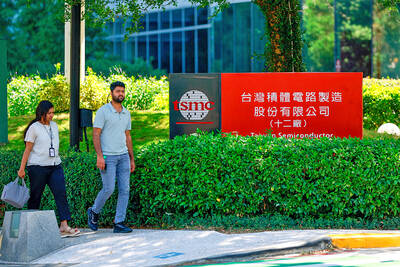A Chinese technology regulator on Friday said that it would cooperate with a bank to set up a US$30 billion fund to support the country’s huge electronics supply chain.
The creation of the new fund underscores China’s ambitions to expand its tech capabilities and also signals how those ambitions are being threatened by slowing growth and recent market turmoil.
Official accounts of the fund did not make clear precisely how the money would be spent. However, given the recent weakness in Chinese manufacturing and lower-end electronics manufacturers, it might be intended as a form of stimulus to the tech industry.
The terminology used in media accounts signals China’s bold technology ambitions. Reports about the new fund said it would be used to build a “strong manufacturing country” and an “Internet power.”
A report in state-run media said the fund was created to address problems faced by small and medium enterprises that have come under pressure or folded recently because of a lack of funding.
The report made reference to recent factory closures, specifically pointing out the closing in October last year of Fu Chang Electronic Technology Co (福昌電子), a supplier to telecom equipment makers Huawei Technologies Co (華為) and ZTE Corp (中興).
The fund is to be created through a partnership between an industry group controlled by the Chinese Ministry of Industry and Information Technology and Ping An Bank (平安銀行).
Signaling the importance of the initiative, the signing ceremony was held at the Diaoyutai State Guesthouse in Beijing, which is often used to host visiting dignitaries, and was attended by representatives of many of China’s largest technology companies, including Lenovo Group Ltd (聯想) and Alibaba Group Holding Ltd (阿里巴巴), according to an official release.
Chinese shares have been hit hard this week by concerns about a depreciating currency and slowing growth. That volatility is most likely worsening an already difficult situation for lower-end electronics makers and component suppliers in China.
While China’s largest hardware brands and booming Internet companies tend to attract media attention, the country also has huge numbers of companies that support the electronics supply chain. With low margins and inconsistent orders, many are highly exposed to slowdowns in the worldwide demand for electronics.
The headwinds were highlighted again on Friday, when the Taiwanese electronics manufacturing giant Foxconn Technology Group (富士康) said that last month’s revenue was 20 percent lower than it was in December 2014. The company operates a number of city-size production facilities in China.
In another indication of the pressures on manufacturing in recent months, workers’ rights group China Labour Bulletin said in a recent report that there had been a “massive upsurge” in worker strikes and protests during the second half of last year.
Tracing the uptick in disputes to market turmoil last summer, the organization said it had tracked twice as many incidents last year as it had in 2014
The new fund seems to resemble a separate multibillion-dollar fund, announced in 2014, to provide financing and enable acquisitions to increase the size and sophistication of the country’s semiconductor industry.
In a speech, Zhou Zixue (周子學), who leads the industry group overseeing the new fund, emphasized the importance of market forces, using language similar to that used in announcing the semiconductor fund.
Zhou, who is the chairman of Semiconductor Manufacturing International Corp (中芯), also said that the new fund would support “supply side” policies. That phrase, recently popular, although less than precise, is usually used by Chinese economic policymakers to emphasize reducing excess manufacturing capacity and moving toward a more consumption-driven economy.
Still, Zhou said that the financing would be used to develop advanced technologies and support companies that are facing financing difficulties, an indication that it might not ultimately lead to a reduction in China’s huge number of low-cost electronics manufacturers.
Over the past year, the semiconductor fund has been used to finance a number of strategic investments and acquisitions in foreign chip companies.
Foreign trade groups have said it gives unfair advantage to Chinese companies and is a tool of Beijing’s industrial policies. It is unclear whether the new fund is to be used to support acquisitions.

RECYCLE: Taiwan would aid manufacturers in refining rare earths from discarded appliances, which would fit the nation’s circular economy goals, minister Kung said Taiwan would work with the US and Japan on a proposed cooperation initiative in response to Beijing’s newly announced rare earth export curbs, Minister of Economic Affairs Kung Ming-hsin (龔明鑫) said yesterday. China last week announced new restrictions requiring companies to obtain export licenses if their products contain more than 0.1 percent of Chinese-origin rare earths by value. US Secretary of the Treasury Scott Bessent on Wednesday responded by saying that Beijing was “unreliable” in its rare earths exports, adding that the US would “neither be commanded, nor controlled” by China, several media outlets reported. Japanese Minister of Finance Katsunobu Kato yesterday also

Taiwan’s rapidly aging population is fueling a sharp increase in homes occupied solely by elderly people, a trend that is reshaping the nation’s housing market and social fabric, real-estate brokers said yesterday. About 850,000 residences were occupied by elderly people in the first quarter, including 655,000 that housed only one resident, the Ministry of the Interior said. The figures have nearly doubled from a decade earlier, Great Home Realty Co (大家房屋) said, as people aged 65 and older now make up 20.8 percent of the population. “The so-called silver tsunami represents more than just a demographic shift — it could fundamentally redefine the

China Airlines Ltd (CAL, 中華航空) said it expects peak season effects in the fourth quarter to continue to boost demand for passenger flights and cargo services, after reporting its second-highest-ever September sales on Monday. The carrier said it posted NT$15.88 billion (US$517 million) in consolidated sales last month, trailing only September last year’s NT$16.01 billion. Last month, CAL generated NT$8.77 billion from its passenger flights and NT$5.37 billion from cargo services, it said. In the first nine months of this year, the carrier posted NT$154.93 billion in cumulative sales, up 2.62 percent from a year earlier, marking the second-highest level for the January-September

‘DRAMATIC AND POSITIVE’: AI growth would be better than it previously forecast and would stay robust even if the Chinese market became inaccessible for customers, it said Taiwan Semiconductor Manufacturing Co (TSMC, 台積電) yesterday raised its full-year revenue growth outlook after posting record profit for last quarter, despite growing market concern about an artificial intelligence (AI) bubble. The company said it expects revenue to expand about 35 percent year-on-year, driven mainly by faster-than-expected demand for leading-edge chips for AI applications. The world’s biggest contract chipmaker in July projected that revenue this year would expand about 30 percent in US dollar terms. The company also slightly hiked its capital expenditure for this year to US$40 billion to US$42 billion, compared with US$38 billion to US$42 billion it set previously. “AI demand actually